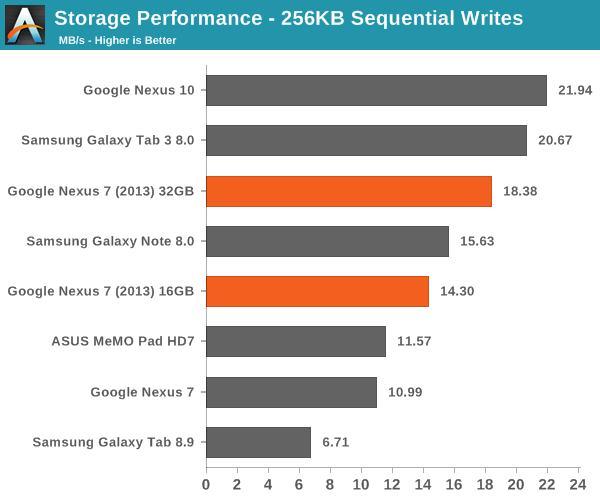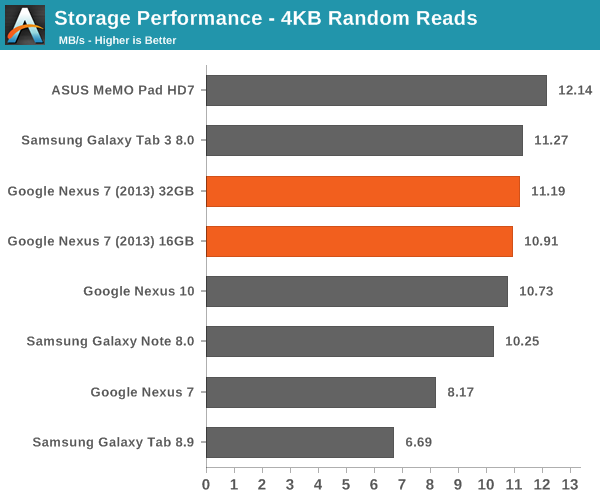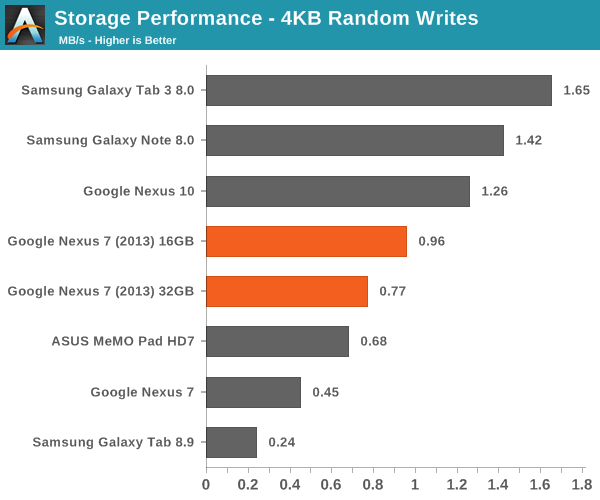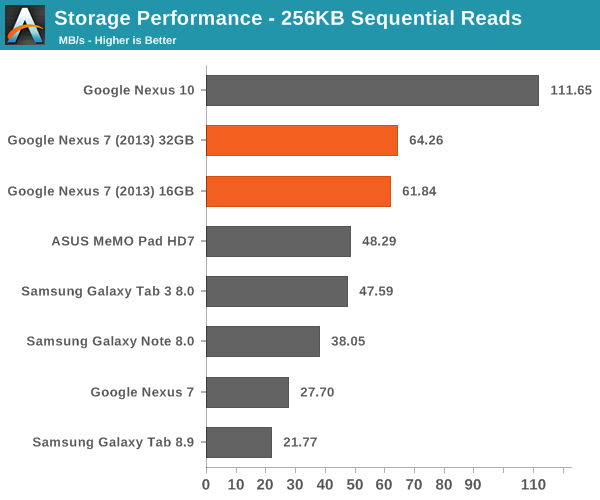The Nexus 7 (2013) Review
by Anand Lal Shimpi on August 22, 2013 6:00 PM ESTeMMC and FSTRIM
The new Nexus 7 obviously ships with the latest version of Android (4.3), which happens to add a major feature for keeping storage performance high: fstrim. Modern smartphones and tablets fundamentally use a very similar storage architecture to what we see in modern SSDs (solid state drives) in PCs. Instead of a drive featuring a discrete controller, DRAM and NAND flash, these ultra mobile devices typically feature one or two NAND devices with an integrated controller - typically eMMC. To keep costs (and power consumption) low there's also no DRAM cache, which definitely harms performance.
Since the underlying architectures are quite similar, the pitfalls are the same as well. The biggest issue? Performance when operating in a full or near-full state. With tons of files on your internal storage, the data structures that have to track all of those files and where they're located in NAND space get pretty complex, and traversing those structures takes a considerable amount of time. The part that many seem to forget is that once you delete a file in Android, it's not immediately removed from internal storage. The space is freed up in the OS, but the eMMC controller still tracks all of the data as valid bits. It's only when that data is overwritten that the controller knows the previous data didn't matter.
In other words, it's possible to have tons of free space on your internal storage, but have the drive appear full to the eMMC controller (and thus enjoy all of the terrible performance that goes along with it). To make matters worse, you never even have to fill your drive to get it into this state. In order to maintain even wear across all NAND cells (to extend the lifespan of the NAND flash), the eMMC controller will write to new/empty blocks in NAND as much as possible. Let's say you have 10GB of storage and Android writes 1GB of data to new addresses every month and deletes the previous 1GB each time. As long as the addresses being written to never overlap, your drive will be full in 10 months (from the eMMC controller's perspective) but Android will still report 9GB of free space.
fstrim establishes communication between the OS and the eMMC controller to address this problem - and it's enabled in Android 4.3.
Unlike TRIM on standard SSDs, FS_TRIM works more like the manual/scheduled TRIM tools from the early days of consumer SSDs. From Brian's original Android 4.3/TRIM article:
The Android framework will send out a “start idle maintenance window” event that the MountService listens for, and then invokes vold to fstrim filesystems when a few conditions have been met – the device hasn’t been touched for over an hour, no idle maintenance window event has been sent in 24 hours, and the device is either off-charger with 80% battery or on-charger with 30% battery. The goal is to have fstrim run roughly once every 24 hours if you’re in the habit of plugging the device in to charge every night.
Personally I feel like the rules are a bit excessive and I'd love to see us get to active TRIM on these devices, but I guess it's a bit too early for that. Basically if your device has enough charge and you're not using it, Android 4.3 will issue an fstrim command to the eMMC controller. The command passes along a list of all unallocated addresses in the filesystem, which the eMMC controller can then use to purge its logical to physical mapping table/list/datastructure. The process should complete relatively quickly as no new data has to be written, the controller just needs to do some cleanup of internal structures and add a bunch of addresses to the unused block pool. Keep in mind that this simply addresses the issue of your storage getting slower over time. fstrim does nothing to keep performance high if you actually fill your storage to capacity. Given how bad these eMMC solutions are, my recommendation is to try and keep at least 20% of your internal storage unused/as free space.
To showcase just how bad things can get I actually dusted off last year's Nexus 7 and treated it like an SSD. I first filled the device with sequential data, leaving only 300MB free. I then performed back to back random writes across the remaining free space and the performance reduction:
| Nexus 7 (2012) Storage Performance | ||||||
| Sequential Read | Sequential Write | Random Read | Random Write | |||
| New After Factory Reset | 25.18 MB/s | 10.63 MB/s | 7.08 MB/s | 0.45 MB/s | ||
| 1st Run After Fill | 22.25 MB/s | 1.21 MB/s | 7.62 MB/s | 0.14 MB/s | ||
| 2nd Run After Fill | 26.00 MB/s | 1.97 MB/s | 7.8 MB/s | 0.11 MB/s | ||
| 3rd Run After Fill | 24.57 MB/s | 3.18 MB/s | 7.96 MB/s | 0.16 MB/s | ||
| After ~24 hours Idle Time | 27.03 MB/s | 11.21 MB/s | 7.65 MB/s | 0.46 MB/s | ||
The columns to pay the most attention to are the write columns (read performance shouldn't change over time). Note that sequential write speed drops by almost an order of magnitude. This incredible drop in performance manifests itself as pauses or stutters. Even when you're just performing simple tasks on your tablet, there are usually tons of background operations going on (e.g. updating system logs). If you look at random write performance here, we see performance drop down to 0.11MB/s - or roughly 27 IO operations per second. If you have more than that amount of IO coming in at the same time, what you'll get are long pauses while the eMMC controller works through its IO queue. Although I didn't include it in the table above, I spent a full day torturing the eMMC on this Nexus 7 and managed to get random write performance as low as 0.02MB/s or 5 IOPS. Sequential write performance in that case was 0.81MB/s, equally disheartening. My point here is that worst case storage performance can get very bad, but looking at the last line of the table you see the incredible impact fstrim has on restoring performance.
I/fstrim ( 118): Starting fstrim work...
I/fstrim ( 118): Invoking FITRIM ioctl on /cache
I/fstrim ( 118): Trimmed 445079552 bytes on /cache
I/fstrim ( 118): Invoking FITRIM ioctl on /data
I/fstrim ( 118): Trimmed 13637656576 bytes on /data
I/fstrim ( 118): Finished fstrim work.
Anyone who had issues with their Nexus 7 slowing down over time will want to upgrade to Android 4.3. Those users considering upgrading to the new Nexus 7 should be fine thanks to fstrim. The only situation where you should see tremendous decrease in storage performance, resulting in IO latency enduced pausing/stuttering is if you physically fill the internal storage close to capacity. Again - my recommendation here is to try and leave at least 20% of your internal storage free. Note that this recommendation applies across Android and iOS.
With all of that out of the way, how does the eMMC solution in the new Nexus 7 stack up? Sequential read performance continues to be quite good for such a small/lower power device. Sequential write speed isn't terrible either. Even random read performance looks solid. It's random write performance that just needs work across the industry. We realistically need to probably be at 10x where we are today in random write performance, perhaps a bit lower if the storage makers can focus on IO consistency/minimum sustained IOPS.
Storage solutions in these tablets are often sourced from multiple vendors, and we can see dramatic differences in performance between them. Brian's review sample was a 32GB model, while the tablet I reviewed had 16GB. The two solutions performed pretty similarly, although my 16GB model did have appreciably better random write performance. Ultimately if you need the space, the 32GB model will be the better performer (you're better off using 45% of a 32GB model than 90% of a 16GB model).














202 Comments
View All Comments
tailwhip - Friday, August 23, 2013 - link
Great review, the only error is you say the screen has 1200 lines but it actually has 1080.ASEdouardD - Friday, August 23, 2013 - link
It's actually right. There are 1200 lines. Space for the virtual buttons.Impulses - Friday, August 23, 2013 - link
It's a 16:10 display, 1920x1200. I'm glad too, cause 16:9 starts to get uncomfortably narrow in portrait (even at 10", try some of the Win 8 tablets).Da W - Friday, August 23, 2013 - link
For that mather i'll take a USB 3.0 port with USB keys.YuLeven - Friday, August 23, 2013 - link
Concerning the iOS x Android comparision, it really puzzles me the fact that people always assume that iOS is 'easy and great for ordinary people' and Android is for geeks.Whether that may be true for many cases, i'd like to say that's not mine. I'm an absolutely ordinary guy. I work as a Japanese instructor and my interest in gadgets does't stretch anywhere near to custom ROM's, high-end gaming or that sort of thing.
Having owned an iPad mini and dumped it later for a Galaxy Note II, I must say that the Android ecosystem actually was by far more compelling to my work.
PDF experience was pretty much the same in both systems, but iOS's dictionaries apps pales in comparision to those on Android in terms of accuracy and usability. Apps focused on teach the language, as the one's used for flashcards and that sort of thing, followed the same experience. Browsing seemed pretty much the same as I care the most about what it's being displayed rather them scrolling like a freak to see which one is the smoothest. And last but not least, beign forced to convert my video files used in lessons with iTunes whas annoying as it can be. Other features dubbed as gimmick as how Android handle its multi-tasking actually helps me a lot.
Of course I used my tablet/phablet outside the classes and never felt cramped in both systems, though.Yet again watching videos on an Apple device was annoying for being forced to spend hours converting my files.
That's however just my opinion. I can bet that there are not that many Japanese teachers arround buying tablets, I just wanted to say that this argument of 'more optimized APPs' and 'better for ordinary people' it's not always true. Specially on the APP side. People are yet to point me an APP that is lacking on Android for my uses, but there where a few cases on iOS.
And i'd like to point too that all this smoothness thing sound just like bollocks for me. Android seems to be fast enough as I won't die for a stutter or other. Rather i'm please with it as it suits me better than iOS.
ASEdouardD - Friday, August 23, 2013 - link
Your reading an Anandtech review and know what a ROM is. Your way above the average tech user.ASEdouardD - Friday, August 23, 2013 - link
Good God, ''You're''.amdwilliam1985 - Monday, August 26, 2013 - link
I know, I felt the same thing, Android are for the geeks, iOS and touchwiz are for the norm. All my friends running Android devices are using varies Galaxy devices. My girlfriend dumped her iphone 4s and went with SGS4 because touchwiz was the easier for her to use.touchwiz > iOS > Android
lol
caleblloyd - Friday, August 23, 2013 - link
When Anand says "order of magnitude" (which he says a lot), does he mean base-2 or base-10?Aaimnr - Thursday, August 29, 2013 - link
When Anand puts some numbers in his reviews (which he does a lot), does he use base-2 or base-10?